How to Use ChatGPT to Write a Blog Post (2024 Guide)
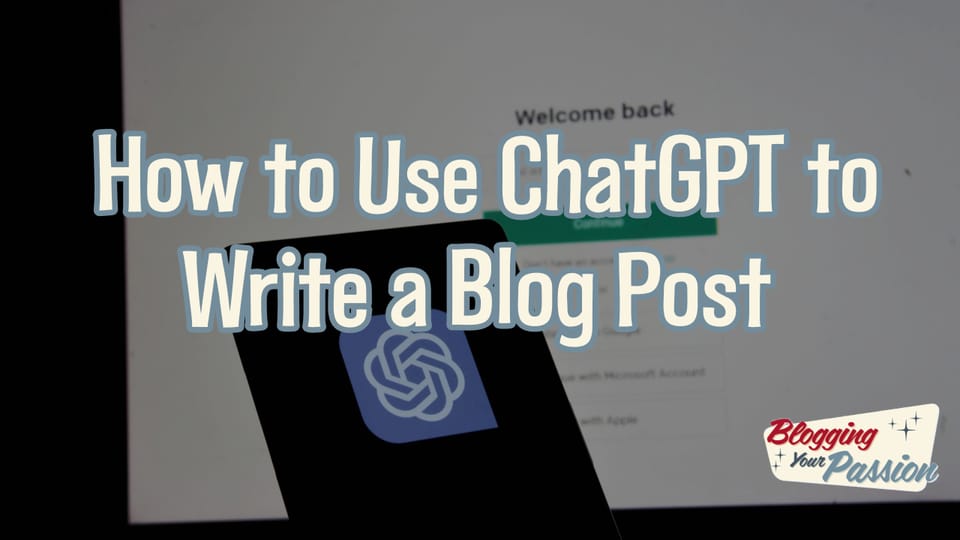
ChatGPT is a game-changing AI tool that has become an invaluable asset in how I approach blog writing.
This cutting-edge language model can generate human-like text on virtually any topic with just a few detailed prompts from me, making it easier than ever before to create high-quality, SEO-optimized blog posts.
In this post, I’ll walk through step-by-step how I leverage the power of artificial intelligence to easily write complete blog articles that resonate with a wider audience.
From conducting keyword research to structuring an engaging outline to optimizing the final draft, you’ll learn my best practices for using ChatGPT to significantly streamline my own content creation workflow.
The key is that I provide ChatGPT with relevant information upfront so it can produce on-topic blog posts packed with useful, detailed insights. I’ll cover exactly how I frame effective prompts to get phenomenal results.
With some initial guidance, ChatGPT can churn out posts with cohesive flow, good grammar, a conversational tone suited for my target readers, and targeted usage of keywords.
While no AI can fully replace human creativity and judgment yet in my opinion, ChatGPT has become an invaluable writing assistant for me.
This post will demonstrate easy ways I systematically utilize its advanced natural language capabilities to save time, blast through writer’s block, and create compelling content optimized for both search and social.
The best part is you don't need an advanced degree in AI to benefit from this system! AI-generated content is here to stay and having a plan to leverage it is key.
Let's explore exactly how I tap into this powerful tool to efficiently produce long-form content.
Table of Contents (click to expand)
- How to Use ChatGPT to Write a Blog Post (Full Demo)
- Step 1: Finding a Topic and Keywords
- Step 2: Outlining the Blog Post
- Step 3: Writing the Initial Draft with ZimmWriter
- Step 4: Optimizing the Draft with RankIQ and ChatGPT
- Step 5: Finalizing the Blog Post
- Step 6: Publishing and Promoting the Blog Post
- Frequently Asked Questions
- Conclusion
How to Use ChatGPT to Write a Blog Post (Full Demo)
If you want to watch over my shoulder as I write an article using ChatGPT, then this video is a great step-by-step guide. You can see first hand my content creation process and how I use AI content generators to write full blog posts.
Step 1: Finding a Topic and Keywords
The first step in utilizing ChatGPT to write a compelling blog post is choosing a worthwhile topic and researching relevant keywords.
When I'm looking to generate blog article ideas, I like to use helpful AI tools like RankIQ and LowFruits to uncover interesting angles around themes that intrigue me personally.
For example, if I was interested in testing out ChatGPT's content creation abilities, a natural blog topic could be "How to Use ChatGPT to Write High-Quality Blog Posts."
I would first enter this tentative title into RankIQ to get keyword suggestions based on top-ranking pages in search engines.
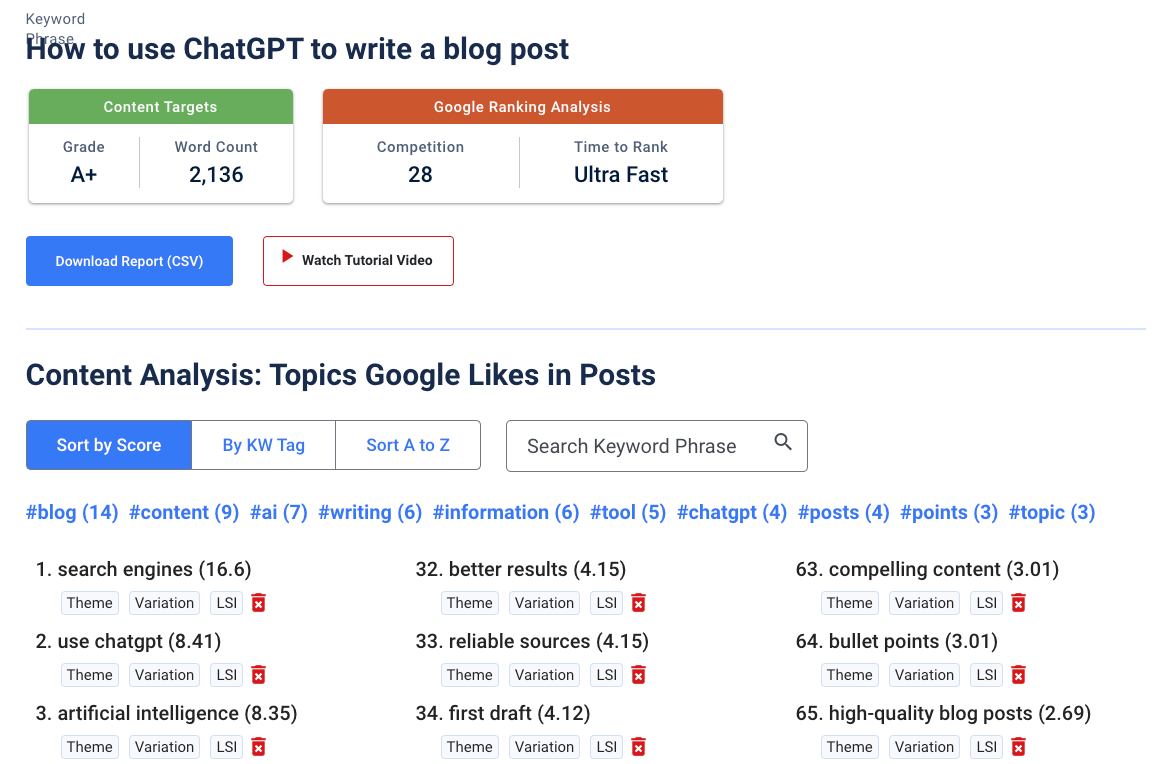
This gives me confidence I’m targeting keywords people are actually searching for when looking for detailed information on this specific topic.
LowFruits is another great AI assistant I use in tandem for keyword research.
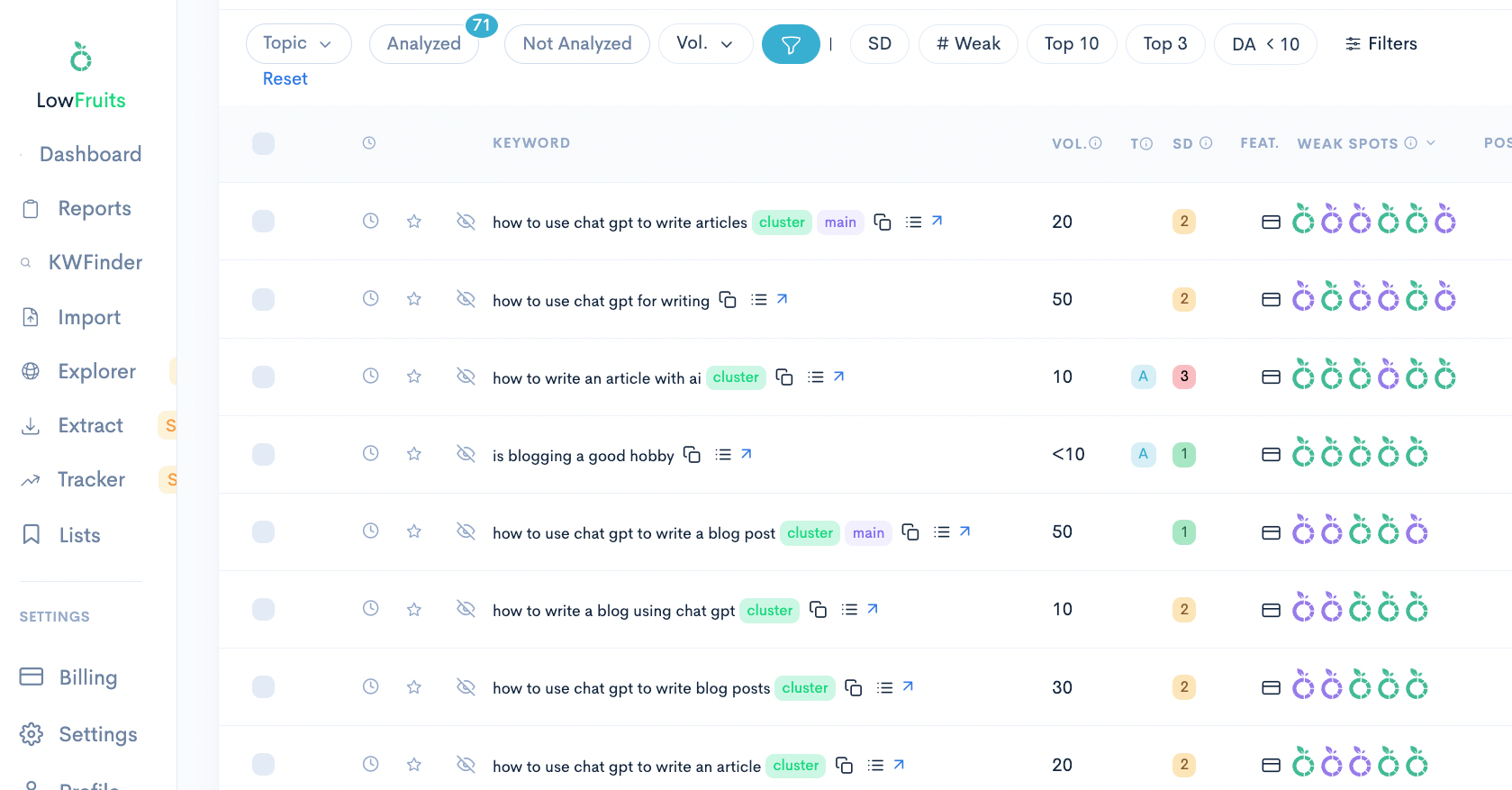
I simply enter my main topic concept and LowFruits scans the web to discover related long-tail keyword ideas optimized for organic search traffic. It also evaluates difficulty to rank for each keyword phrase.
This helps me home in on the best blog post topic that balances relevance, value, and competitiveness.
Once I’ve narrowed down the perfect blog title and outline incorporating engaging keywords, I’m ready for ChatGPT to start generating the actual post.
The key is crafting the initial prompt clearly explaining the topic, target keywords, structure, and ideal tone. This front-end effort pays off hugely in guiding ChatGPT to produce on-point blog drafts tailored to my goals.
Step 2: Outlining the Blog Post
Once I’ve settled on a compelling topic and researched relevant keywords, the next vital step is creating a strong blog outline for my AI content generator tool to follow.
When using ZimmWriter to produce complete blog articles, starting with a detailed outline is key. I typically structure my blog post outlines with H2 and H3 headers representing the key sections I want covered, along with a list of target keywords.
To come up with a good outline template, I’ll analyze a few top-ranking competitor articles on my chosen blogging topic for ideas. I copy the basic structure from their content as a starting point.
Then I input this outline into ChatGPT along with a brief description of my target audience, tone and intent. I prompt ChatGPT to suggest improvements to make the outline more compelling while seamlessly incorporating the keywords I want to focus on.
This collaborative process helps lock down an engaging blog post outline catered to my goals. I may tweak a few things based on my own experience and ideas as well.
The resulting outline acts as the blueprint for ZimmWriter to follow when generating a top-notch initial draft quickly and automatically. With clear guidance upfront, ZimmWriter can produce surprisingly coherent blog posts even for in-depth topics.
Step 3: Writing the Initial Draft with ZimmWriter
Now that I have a strong topical outline with relevant keywords laid out, it’s time for my AI assistant ZimmWriter to get to work producing an initial first draft.
After connecting my ChatGPT API keys once in the ZimmWriter app, it only takes a few clicks to churn out complete blog articles in minutes. I simply paste my blog post title and H2 outline headers into the designated fields in ZimmWriter.
Next, I input all my target keywords I want organically incorporated throughout the post. I enable handy features like bullet lists and FAQs as well to boost engagement.
I find that selecting “Start SEO Writer” with default settings consistently yields excellent first drafts. ZimmWriter seamlessly spins up lengthy, cohesive posts reaching upwards of 2000+ words formatted in markdown.
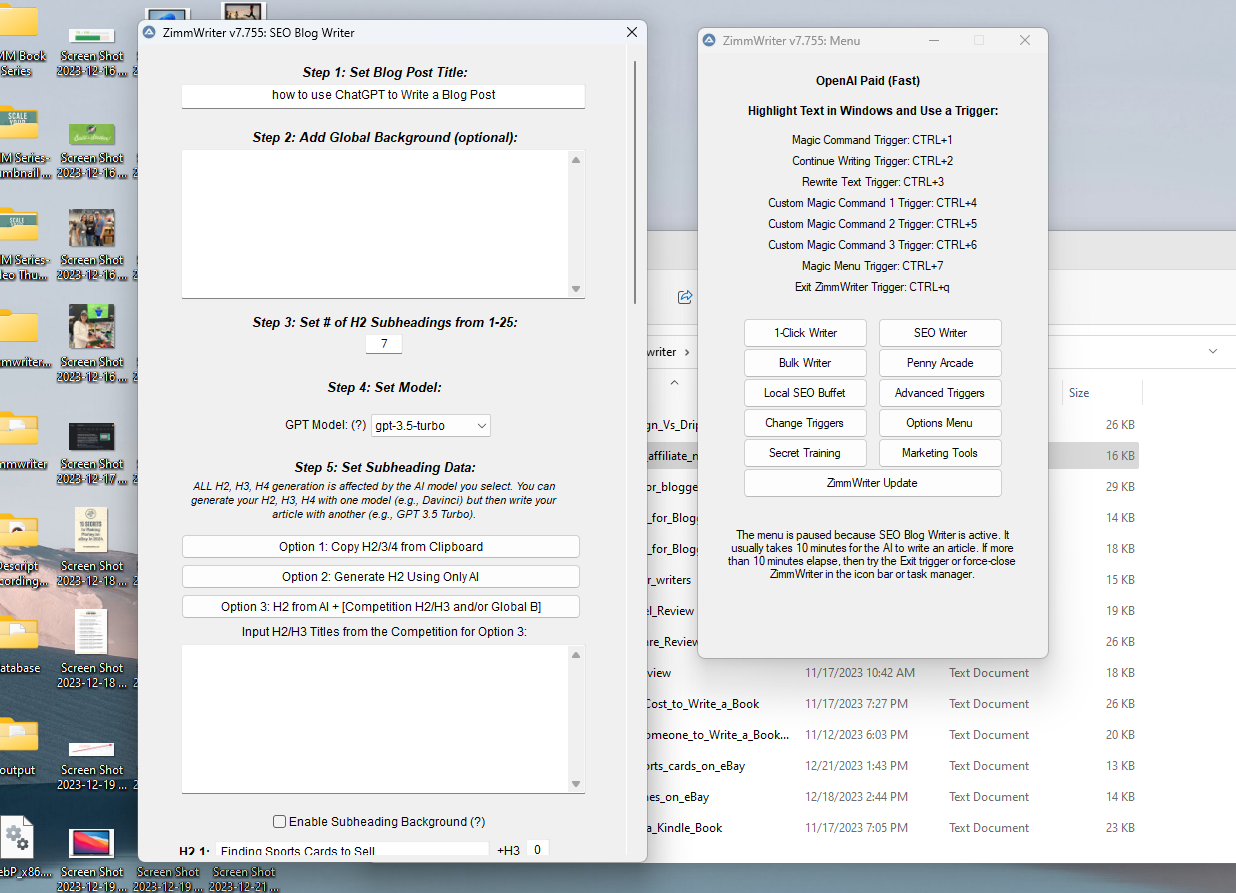
The automatically generated posts cover all aspects laid out in my initial outline while smoothly integrating my selected keywords. I’m always impressed with how ZimmWriter produces multiple paragraphs elaborating on each outline section.
The readable blog draft serves as the perfect starting point I can then optimize further. ZimmWriter cuts the time of writing from scratch down to just minutes while handling much of the "heavy lifting."
This allows me to focus my efforts on enhancing and personalizing the content in later steps.
Step 4: Optimizing the Draft with RankIQ and ChatGPT
Now that I’ve used ZimmWriter to efficiently generate a complete initial draft, the next step is optimizing the content further. This is where additional AI tools RankIQ and ChatGPT come in handy again.
First, I run the draft through RankIQ’s Content Optimizer to analyze how optimized it is for ranking potential and to catch any leftover target keywords I can still incorporate.
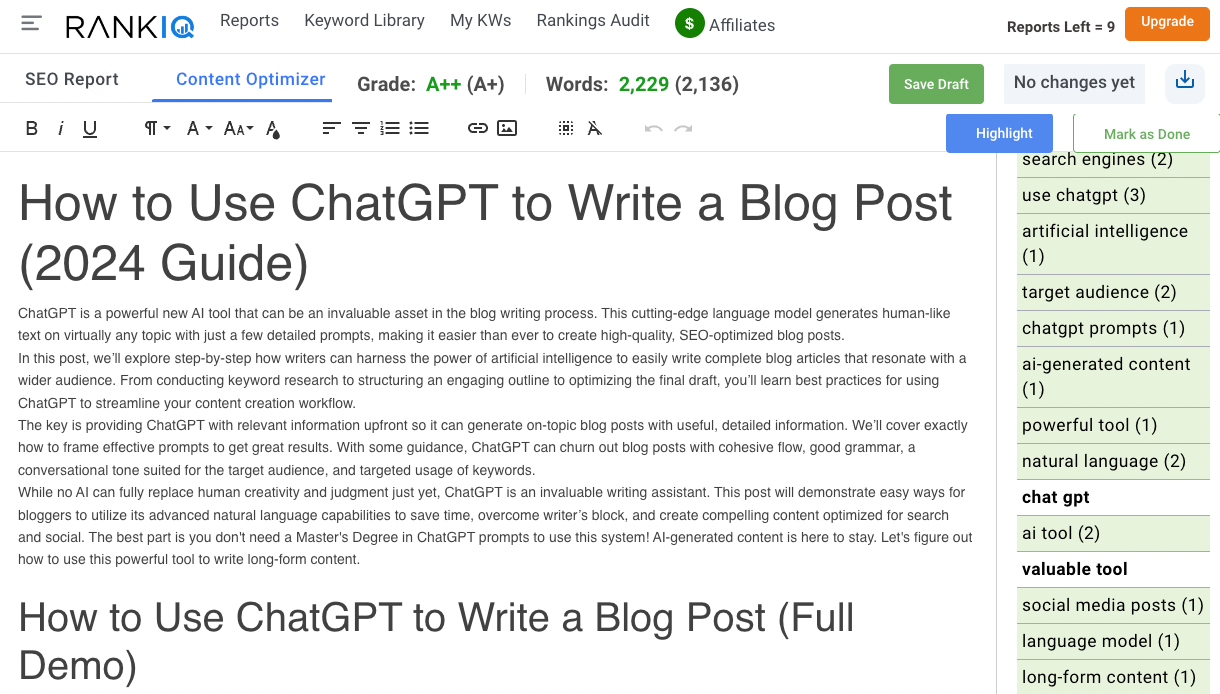
I may see opportunities to add supporting statistics, external resources, or elaboration around headline points to improve authority and search visibility.
If RankIQ highlights unused keywords remaining, I’ll craft a follow-up prompt for ChatGPT such as: “Please add 5 concise FAQs to cover these leftover keywords on the topic of ChatGPT for blogging.”
This seamlessly incorporates remaining keywords I’m targeting in natural sounding FAQs.
I also take this chance to have ChatGPT rephrase awkward sentences or beef up skimmable paragraphs by prompting: “Please expand and improve the readability of Section 3 while keeping the core information intact.”
Leveraging RankIQ and ChatGPT in tandem allows me to take my initial draft to the next level, elevating coherence, engagement, and keyword coverage. I spend this optimization step honing the copy before applying my own personal touch.
The resulting post is now a polished, comprehensive piece with expanded sections, smooth transitions, and targeted search terms woven throughout. Collaborating with my AI tools ensures my draft checks all the boxes before finalizing publishing.
Step 5: Finalizing the Blog Post
Once I’m happy with the optimized draft, it’s time for some finishing touches before publishing this AI-generated blog content.
First, I carefully proofread the post, catching any lingering typos or repetitive phrasing while reading for coherent flow. I may tweak a transition or two as I go. When writing with AI support, having a human editor is still essential.
Next, I incorporate relevant internal links to related posts to boost engagement. These connections encourage readers to keep exploring my site.
I’ll also add external links to authoritative external websites to reinforce key points, lending credibility.
Now my post is polished and link-optimized. From there, I can format for a visually engaging reading experience - breaking up lengthy paragraphs, using headers, bolding key terminology, adding pull quotes, images or graphics as needed.
Finally, I run the complete piece through a plagiarism checker. While AI article writing tools generate fully original copy, it never hurts to verify before indexing. A tool like PlagiaShield gives me peace of mind.
With a final manual review, thoughtful formatting for readability and plagiarism checks, my AI-generated blog article is now truly ready for the big reveal! Publishing optimized, captivating blogs in a fraction of the time is now achievable with AI.
Step 6: Publishing and Promoting the Blog Post
My AI-generated blog content is now complete and ready to publish out into the world!
The final step is publishing the post on my blog and actively promoting it to drive traffic from both search engines as well as social media.
For on-page SEO, I’m strategic with formatting using keywords in headers, URLs, meta descriptions and within image alt text. This elevates discoverability for organic searches.
I also tap into my social networks, sharing snippets and commentary natively on platforms like Facebook, Twitter and LinkedIn. I may even repurpose portions into short “teaser” posts across networks to maximize reach.
Emailing new posts out to my engaged mailing list subscribers also helps get content I create using AI writing tools in front of an audience I know values my work.
Driving more eyeballs to each post I produce leveraging these AI-generation methods keeps building organic growth over time.
Plus, getting more feedback and comments continually trains these language models to output better content calibrated to what resonates with readers.
The more content I publish created with the assistance of ChatGPT and tools like ZimmWriter, the stronger my results become across channels. My site benefits from both surging search visibility as well as social word-of-mouth.
Frequently Asked Questions
How can ChatGPT support creating better blog content?
ChatGPT is an innovative AI tool that can generate original long-form blog posts when given the right prompts. Its natural language capabilities streamline writing by effortlessly producing complete drafts to build upon.
What kind of blog topics can ChatGPT help write articles about?
This cutting-edge AI model can create blog content on virtually any topic when provided with some initial background details and direction. Effective prompts lead to informative posts with cohesive flow.
Does ChatGPT blog content pass plagiarism checks?
Yes - AI-generated blog paragraphs are fully unique, passing plagiarism checks when publishing original created content. However, always run completed posts through a duplicate content checker for peace of mind.
How can ChatGPT improve my blog writing workflow?
ChatGPT alleviates writer’s block by instantly generating draft blog articles to your outlined specifications. Optimizing and finalizing that draft remains essential, but the heavy lifting of writing is done.
What tone and structure should I specify for ChatGPT blog content?
When prompting ChatGPT, clearly indicate your target reader, desired tone (conversational, informative, etc) and provide an outline with main points covered to maintain coherence in generated posts.
Does ChatGPT incorporate keywords naturally in blog paragraphs?
Yes, inputting a list of relevant main keywords upfront will lead ChatGPT to effortlessly weave them throughout all sections rather than awkwardly over-packing each sentence.
Can ChatGPT properly format a blog post while writing?
While ChatGPT generates clean copy, light formatting touch-ups are still needed before publishing the final product. Break up lengthy paragraphs, bold key terminology, add headers and imagery to finish posts.
How can I optimize a ChatGPT blog draft further?
Tools like RankIQ Content Optimizer help improve initial drafts by catching leftover target keywords to cover along with providing expansion suggestions to beef up paragraphs.
Should I edit anything before publishing ChatGPT blog content?
Completing a full manual review allows catching any disjointed sentences potentially needing tweaks or tightening while ensuring posts have cohesive flow and structure.
Does ChatGPT provide value with other social creative copy?
Yes, the AI copywriting capabilities powering ChatGPT can be harnessed to effortlessly generate written social media posts, emails, ad copy and more. The key is crafting effective prompts.
Conclusion
Creating optimized, engaging blog content quickly is now more achievable than ever thanks to the rise of advanced AI language models like ChatGPT.
As this post demonstrated in detail, writers can truly amplify their blogging workflow by collaboratively harnessing the power of AI.
The key is crafting thoughtful prompts upfront indicating goals, structure, target keywords and ideal tone. Tools like ZenWriter then effortlessly transform those directives into complete quality drafts in minutes.
Other AI optimization tools help take posts to the next level before applying finishing edits and your own personal touch.
Publishing frequently using this collaborative AI process leads to positive compounding benefits over time. Your site gains search visibility and social traction while continually training language models on what resonates best with your audience.
Quality original writing was once a major struggle for bloggers. But AI advancements have eased creative barriers immensely while potentially reaching wider audiences.
Yet that human creativity and judgment remains vital in reviewing content generated.
In closing, hopefully this post served as an actionable blueprint illustrating exactly how ChatGPT can transform blog writing.
With the right guidance upfront paired with prudent oversight, AI promises to help creators, marketers and entrepreneurs thrive. Just remember - your prompts power your results!
